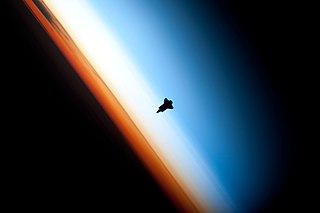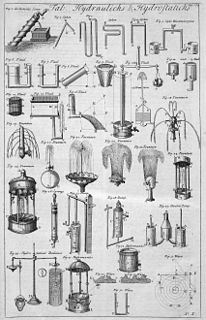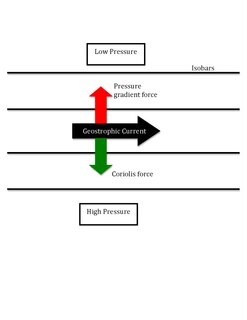
In fluid dynamics, a barotropic fluid is a fluid whose density is a function of pressure only. [1] The barotropic fluid is a useful model of fluid behavior in a wide variety of scientific fields, from meteorology to astrophysics.

In physics and engineering, fluid dynamics is a subdiscipline of fluid mechanics that describes the flow of fluids—liquids and gases. It has several subdisciplines, including aerodynamics and hydrodynamics. Fluid dynamics has a wide range of applications, including calculating forces and moments on aircraft, determining the mass flow rate of petroleum through pipelines, predicting weather patterns, understanding nebulae in interstellar space and modelling fission weapon detonation,
The density of most liquids is nearly constant (isopycnic), so it can be stated that their densities vary only weakly with pressure and temperature. Water, which varies only a few percent with temperature and salinity, may be approximated as barotropic. In general, air is not barotropic, as it is a function of temperature and pressure; but, under certain circumstances, the barotropic assumption can be useful.
An isopycnic surface is a surface of constant density inside a fluid.
In astrophysics, barotropic fluids are important in the study of stellar interiors or of the interstellar medium. One common class of barotropic model used in astrophysics is a polytropic fluid. Typically, the barotropic assumption is not very realistic.
Astrophysics is the branch of astronomy that employs the principles of physics and chemistry "to ascertain the nature of the astronomical objects, rather than their positions or motions in space". Among the objects studied are the Sun, other stars, galaxies, extrasolar planets, the interstellar medium and the cosmic microwave background. Emissions from these objects are examined across all parts of the electromagnetic spectrum, and the properties examined include luminosity, density, temperature, and chemical composition. Because astrophysics is a very broad subject, astrophysicists apply concepts and methods from many disciplines of physics, including mechanics, electromagnetism, statistical mechanics, thermodynamics, quantum mechanics, relativity, nuclear and particle physics, and atomic and molecular physics.
In meteorology, a barotropic atmosphere is one that for which the density of the air depends only on pressure, as a result isobaric surfaces (constant-pressure surfaces) are also constant-density surfaces. Such isobaric surfaces will also be isothermal surfaces, hence (from the thermal wind equation) the geostrophic wind will not vary with depth. Hence, the motions of a rotating barotropic air mass is strongly constrained. The tropics are more nearly barotropic than mid-latitudes because temperature is more nearly horizontally uniform in the tropics.

Meteorology is a branch of the atmospheric sciences which includes atmospheric chemistry and atmospheric physics, with a major focus on weather forecasting. The study of meteorology dates back millennia, though significant progress in meteorology did not occur until the 18th century. The 19th century saw modest progress in the field after weather observation networks were formed across broad regions. Prior attempts at prediction of weather depended on historical data. It was not until after the elucidation of the laws of physics and more particularly, the development of the computer, allowing for the automated solution of a great many equations that model the weather, in the latter half of the 20th century that significant breakthroughs in weather forecasting were achieved.

An isobaric process is a thermodynamic process in which the pressure stays constant: ΔP = 0. The heat transferred to the system does work, but also changes the internal energy of the system. This article uses the chemistry sign convention for work, where positive work is work done on the system. Using this convention, by the first law of thermodynamics,
The geostrophic wind is the theoretical wind that would result from an exact balance between the Coriolis force and the pressure gradient force. This condition is called geostrophic balance. The geostrophic wind is directed parallel to isobars. This balance seldom holds exactly in nature. The true wind almost always differs from the geostrophic wind due to other forces such as friction from the ground. Thus, the actual wind would equal the geostrophic wind only if there were no friction and the isobars were perfectly straight. Despite this, much of the atmosphere outside the tropics is close to geostrophic flow much of the time and it is a valuable first approximation. Geostrophic flow in air or water is a zero-frequency inertial wave.
A barotropic flow is a generalization of a barotropic atmosphere. It is a flow in which the pressure is a function of the density only and vice versa. In other words, it is a flow in which isobaric surfaces are isopycnic surfaces and vice versa. One may have a barotropic flow of a non-barotropic fluid, but a barotropic fluid will always follow a barotropic flow. Examples include barotropic layers of the oceans, an isothermal ideal gas or an isentropic ideal gas.
A fluid which is not barotropic is baroclinic, i. e., pressure is not the only factor to determine density. For a barotropic fluid or a barotropic flow (such as a barotropic atmosphere), the baroclinic vector is zero.

In fluid dynamics, the baroclinity of a stratified fluid is a measure of how misaligned the gradient of pressure is from the gradient of density in a fluid. In meteorology a baroclinic atmosphere is one for which the density depends on both the temperature and the pressure; contrast this with a barotropic atmosphere, for which the density depends only on the pressure. In atmospheric terms, the barotropic zones of the Earth are generally found in the central latitudes, or tropics, whereas the baroclinic areas are generally found in the mid-latitude/polar regions.












